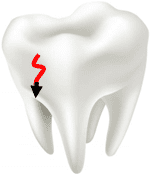Why You Cannot See Cracks on Most X-Rays?


Cracked teeth are one of the most difficult things to diagnose in dentistry. Unless the crack is blatant and visible, they cannot be seen by the naked eye. To make matters worse, a conventional x-ray rarely, if ever, finds a crack. A conventional x-ray is called a periapical radiograph. It is unable to find most cracks because of the angle of the xray beam and location of most cracks. Most cracks are what we call vertical cracks. This means that the cracks starts on the top or center of the tooth and spreads downward. If the crack is allowed the spread down the entire length of the tooth, it will split in half.
When a conventional xray is taken, an xray beam is shot across the tooth at a 90-degree angle. What shows up on the computer screen is everything that is in line with the xray sensor and xray beam. Since most cracks are vertically down the tooth, they will not show up on the xray. This is because the xray beam is not parallel to the crack. Instead, the natural tooth structure will cover up the crack. If the conventional xray does not see anything, this does not mean it is not there. The diagnosis will then have to be made on symptoms. This is why diagnosing a cracked tooth can be SO difficult.



